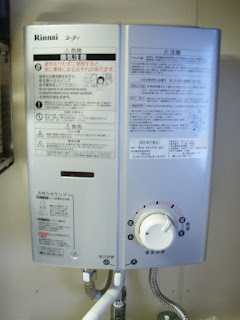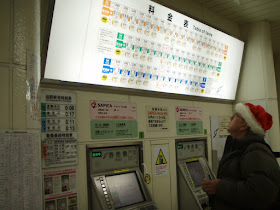Back in September, when we were preparing to move here, Ted bought me a lot of winter things. He knew I hated to shop and also that I would not be able to find things my size here in Japan if I waited to shop. He was able to find great deals shopping online at Sierra Trading Post and other online stores. When the packages started arriving, I said do I really need six pairs of boots and six pairs of slippers and all these coats and long underwear and other things? Apparently I do.
It’s important to dress in layers because even though it is 25 degrees F outside, it’s going to be 90 when you get inside a building and you’ll have to peel some layers off. It’s helpful to have boots you can get out of quickly when you go inside and have to put on your slippers.
If you are going to be walking outside for more than a few minutes, it’s good to have a slick coat and pair of pants on so that the snow will slide off. Jeans are no good because the snow will stick and melt, leaving you with wet pants. Even if it is not snowing as you leave the apartment, it will be in just a few minutes. Believe me.
It’s good to have a down jacket for warmth, covered with a shell or raincoat with a hood. If you are going to be doing something like skiing or snowshowing, a thick fleece covered by a slick jacket will keep you warm and keep the snow off (snow from the sky or from falling and hitting the snow on the ground).
Sometimes you need fuzzy mittens to keep your fingers warm, sometimes heavy gloves, sometimes lightweight running gloves so you can take a picture.
Sometimes you need tall boots, sometimes you need boots with soles like truck tires. I would have turned my nose up at wearing furry boots in Raleigh, but furry is warm and I wear them here.
If you are going snowshoeing, like we did yesterday, you need sturdy boots with this little ridge on the back to hold the snowshoe strap.
We went to an area on the university property where the snow was fresh and fluffy and hadn’t been disturbed yet. It was a lot of fun. The sky was gray, but the snow waited to fall until we were back home.
Practicing Japanese
Cars that have yellow license plates are smaller with smaller engines and their owners get tax advantages. A recent Japanese lesson covered some adjectives like big, small, old, and new. As we were walking home, I saw one of the yellow plate cars and I said to Ted “Atarashii kuruma desu.” Ted wanted to know how I knew the car was new. I had confused atarashii for chiisai (new for small), both words that had been in my lesson. At least the sentence I said made sense, even if it wasn’t what I meant to say. Ted had a friend who once said he wanted to eat kodomo (children), meaning to say kudamono (fruit). No one said learning Japanese would be easy.
I’m learning some kanji on signs. I don’t know what the first line on this sign says, but the double trident looking thing is exit and the square means enter.
I’m thankful we have this opportunity to move here and experience all these new things. The only thing I regret about leaving North Carolina is that we weren’t able to sell our house and were forced to leave it with a property management company to rent it. If you find yourself in a similar situation, let me tell you who not to trust your house with.






















































